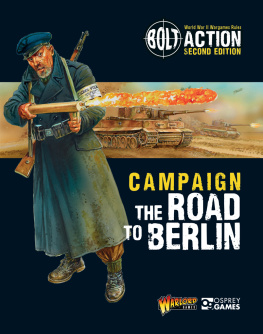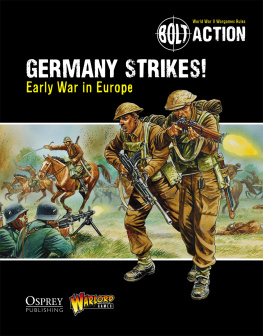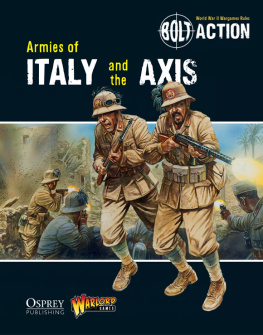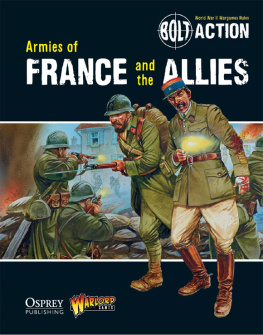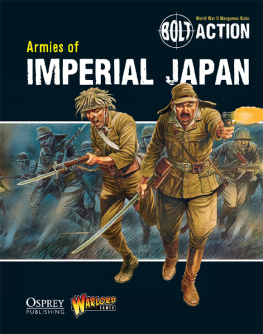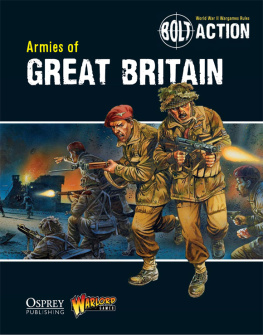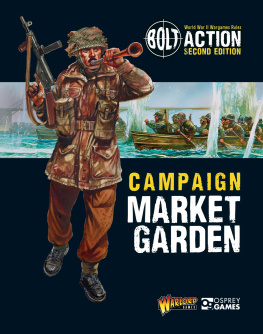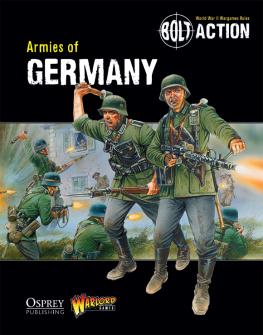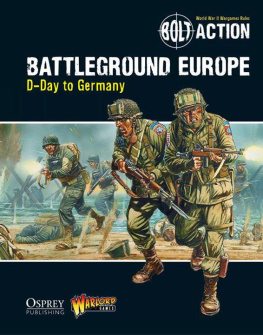
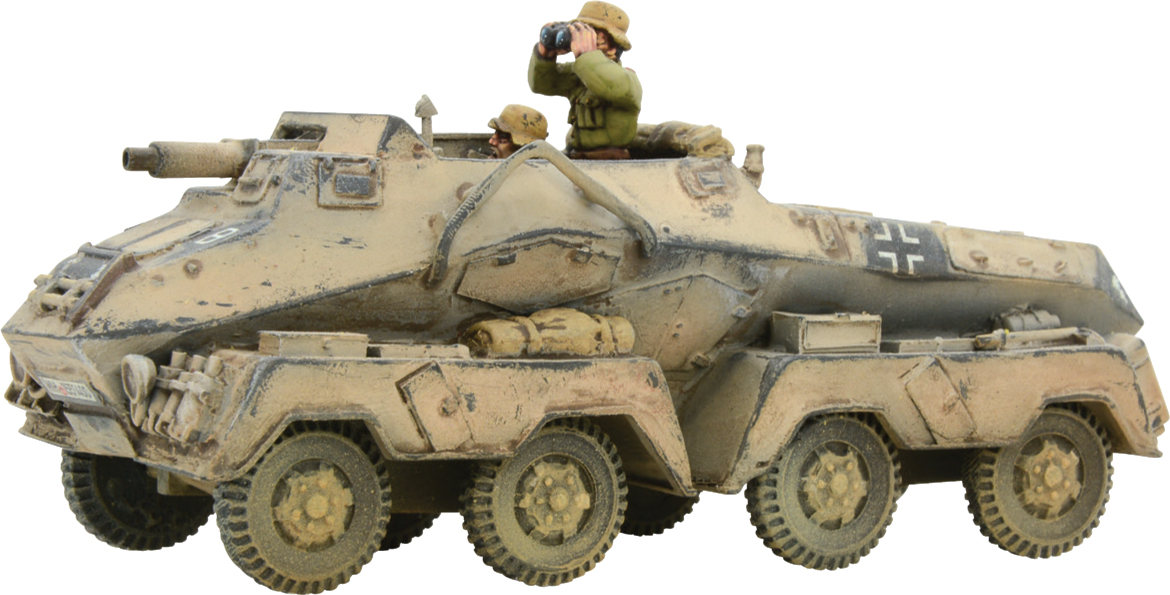
First published in Great Britain in 2016 by Osprey Games (part of Osprey Publishing),
2016 Osprey Publishing Ltd. and Warlord Games
Osprey Publishing
PO Box 883, Oxford, OX1 9PL, UK
1385 Broadway, 5th Floor, New York, NY 10018, USA
E-mail:
This electronic edition published in 2016 by Bloomsbury Publishing Plc
Bloomsbury is a registered trademark of Bloomsbury Publishing Plc
Osprey Publishing, part of Bloomsbury Publishing Plc
Warlord Games
T13/T15 Technology Wing, The Howitt Building, Lenton Business Centre, Lenton Boulevard, Nottingham, NG7 2BD, UK
E-mail:
All rights reserved
You may not copy, distribute, transmit, reproduce or otherwise make available this publication (or any part of it) in any form, or by any means (including without limitation electronic, digital, optical, mechanical, photocopying, printing, recording or otherwise), without the prior written permission of the publisher. Any person who does any unauthorised act in relation to this publication may be liable to criminal prosecution and civil claims for damages.
A CIP catalogue record for this book is available from the British Library
ISBN: 978-1-4728-1780-8 (PB)
ISBN: 978-1-4728-1782-2 (eBook)
ISBN: 978-1-4728-1781-5 (ePDF)
www.ospreygames.co.uk
For more information on Bolt Action and other products, please visit www.warlordgames.com
To find out more about our authors and books visit www.ospreypublishing.com. Here you will find our full range of publications, as well as exclusive online content, details of forthcoming events and the option to sign up for our newsletters. You can also sign up for Osprey membership, which entitles you to a discount on purchases made through the Osprey site and access to our extensive online image archive.

T his is a supplement for the tabletop wargame Bolt Action, and it deals with the German Army of World War II. Within you will find background and details of the German Armys organisation and equipment from the beginning of the war (the invasion of Poland in 1939) to the very end (the fall of Berlin in 1945). Central to this book is its Army List. This includes all the information you will need to play games using the German Army. This large list details all the main troop types, vehicles and equipment fielded by the Germany Army during World War II. Alongside this main list are 18 Theatre Selectors, which give the force details for different periods and theatres of the war. Over six years of fighting the German Army changed a lot, and many units and vehicles that were common in 1939 were obsolete by 1945. These sub-lists allow players to select forces suitable for the theatre in which they are playing. To avoid a lot of repetition, the main list includes all the options and rules information, with the Theatre Selectors narrowing this down to the most appropriate.
Over the course of the war the German Army fielded more than 3,000 different types of vehicle. Many were very rare or even just prototypes; others were captured from the enemy and used against them. It is impossible to cover them all, and so this book does not deal with many of the very rare and unique vehicles, and does not include captured vehicles. Players should feel free to include enemy vehicles in their army if they wish, and if they have their opponents permission, but they will need access to the original nations Army List for the captured vehicles rules (otherwise this volume would have to include every other armys vehicles as well as the Germans).
Likewise, there are always exceptions and oddities that the Theatre Selectors cannot cover. The Theatre Selectors are not definitive, but are designed to give a theatre-specific flavour and character to a force. They only include the predominating equipment of the campaign or period. Exceptions are perfectly acceptable with agreement between players, but cannot be included in the main list without becoming the rule.


A NEW WORLD ORDER
After its defeat in World War I, the Treaty of Versailles subjected the German nation to very harsh punitive rules. As well as war reparations to other nations, part of this treaty enforced severe restrictions on the German Army to prevent it again growing so powerful that it could threaten the peace of Europe or, more specifically, Frances territory.
The Nazi Party, led by Adolf Hitler, was elected to power in 1933. Shortly thereafter, Hitler declared himself Fhrer and these severe foreign restrictions, already widely despised, secretly began to be bent and then broken. Using many ruses to disguise his policy, Hitlers government authorised the re-armament of the German Army as a modern fighting force.

Panzer-Befehlswagen I
German staff officers discuss the coming offensive

By 1939 the Wehrmacht the German Army (Heer), Navy (Kriegsmarine) and Air Force (Luftwaffe) had quietly risen to become (arguably) the most powerful fighting force in Europe. So it had to be, because they would be the primary instruments in realising the Nazi Partys dream of a greater German Reich (its third!): a new world order and German empire that would cover all of Europe and last 1,000 years.
As the war clouds gathered over Europe, first with the German Armys move to reclaim the Rhineland, ceded to France after 1918, followed by the annexation of Austria, the signing of a military alliance with Italy (the Pact of Steel) and the invasion (against no resistance) of the Sudetenland in Czechoslovakia, the German Army began to show the world its new strength. On 1 September 1939, the German Army was ordered to commence the invasion of Poland. This attack was a step too far for Britain and France. They had been powerless or unwilling to stop the earlier transgressions, but both now resolved to stand-by their treaty obligations to Poland and declared war upon Germany. World War II had begun and, although they did not know it then, it would last six years, see fighting across the globe, and cost over sixty million lives the greatest loss of life ever to befall the human race.
TOP SECRET
THE HEER AND BEYOND
The Heer was a highly trained, well-equipped and professional army. Regarded by some as the best fighting force ever to wage war, it was large (over 14 million men, including Germanys many allies), and had one of the worlds largest industrial nations supplying it with vast amounts of excellent equipment. But six years of constant war, especially the huge commitments on the Eastern Front, saw the German Army ground into nothing more than a battered shell. It lost over 4 million men, again mostly in the east, and despite its vaunted levels of training and equipment, it was reduced to conscripting anybody capable of carrying a weapon by the time Berlin fell.
Next page

